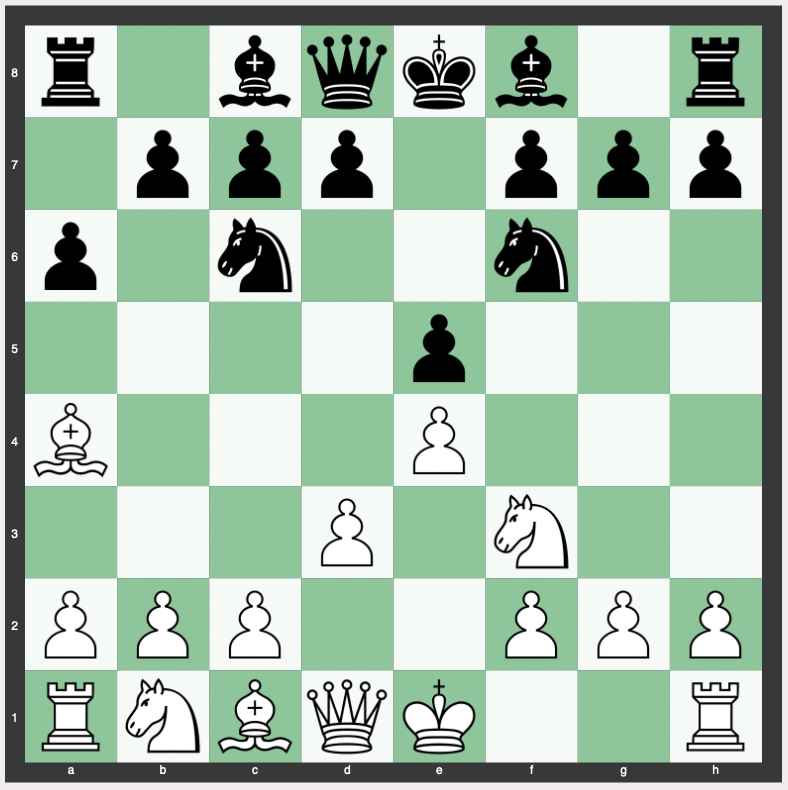The Anderssen Variation of the Ruy Lopez is a dynamic and rich opening, appealing to players who enjoy complex strategic battles.
A key line in this variation starts with 1. e4 e5 2. Nf3 Nc6 3. Bb5 a6 4. Ba4 Nf6 5. d3.
Here we go into the details of the Anderssen Variation, including its move order, theory, strategy, variations, history, and usability at different levels of chess proficiency.
Move Order of the Anderssen Variation
The Anderssen Variation arises from the Ruy Lopez, an esteemed opening named after the Spanish bishop Ruy López de Segura.
It begins with the moves 1. e4 e5 2. Nf3 Nc6 3. Bb5, a fundamental opening known as the Ruy Lopez.
The game then continues with 3…a6, driving the bishop back to a4, followed by 4…Nf6, contesting white’s control of the center.
The characteristic move of the Anderssen Variation is 5. d3, supporting the e4 pawn and opening a pathway for the dark-squared bishop.

Theory, Strategy, and Purpose of the Anderssen Variation
The key idea behind the Anderssen Variation is a solid, albeit slightly passive setup.
The move 5. d3 bolsters the center and prepares for a potentially quick bishop development to g5 or e3, while also allowing White the possibility to castle short.
It also deters Black’s thematic break …d5, aiming for a steady, rather than aggressive, central control.
The subsequent strategy is primarily about harmonious piece development, maneuvering, and strategic pawn breaks.
Sub-Variations of the Anderssen Variation
Within the Anderssen Variation, there are several sub-variations depending on Black’s responses.
Two significant replies from Black at this point are 5…b5 and 5…Bc5.
The 5…b5 move, pushing the bishop back to b3, can lead to variations where Black plays aggressively for a pawn break in the center with …d5.
Alternatively, the 5…Bc5 move aims to challenge for control of the center while emphasizing development and preparing to castle. It is considered the strongest response.
Each of these sub-variations requires its unique set of strategic considerations.
Overall, the Anderssen Variation is considered a small edge for white (+0.05).
Some continuation lines from the Anderssen Variation are:
5… Bc5 6. c3 b5 7. Bb3 O-O 8. O-O d6 9. h3 h6 10. Re1 Re8 11. a4 Rb8 12. Nbd2 Be6 13. Bxe6 Rxe6 14. b4 Bb6 15. Nb3 d5 16. Qe2 d4 17. cxd4 Bxd4 18. Nbxd4 Nxd4 19. Nxd4
5… Bc5 6. Bxc6 dxc6 7. O-O Nd7 8. c3 O-O 9. d4 Bd6 10. Bg5 Qe8 11. Re1 c5 12. Bh4 b5 13. Bg3 Bb7 14. a4 h6 15. Nh4 exd4 16. Bxd6 cxd6 17. Nf5 Qe5
5… Bc5 6. Bxc6 dxc6 7. O-O Nd7 8. c3 O-O 9. d4 Bd6 10. Bg5 Qe8 11. Nbd2 a5 12. Bh4 f6 13. Bg3 a4 14. Re1 Nb6 15. h3 c5 16. Qc2 Bd7
5… Bc5 6. Bxc6 dxc6 7. O-O Nd7 8. c3 O-O 9. Bg5 f6 10. Bh4 a5 11. d4 Bd6 12. Nbd2 a4 13. Qc2 Qe7 14. Bg3 Re8 15. Rfe1 c5 16. dxe5 Nxe5 17. Nxe5 fxe5 18. Nc4 b5 19. Nxd6
History of the Anderssen Variation
Named after the German master Adolf Anderssen, this variation is an example of his approach to chess.
Anderssen, known for his imaginative attacking style, played this variation in the 19th century, though it was less aggressive than many of his other choices.
It’s somewhat ironic that a player known for his tactical brilliancies would lend his name to a solid, strategic opening.
Despite this, the Anderssen Variation offers a lot of strategic depth and potential for outplaying the opponent, reflecting aspects of his chess understanding.
Is the Anderssen Variation Good for Beginners or Intermediates?
The Anderssen Variation is suitable for both beginners and intermediate players.
For beginners, it’s a less complex option than other lines in the Ruy Lopez, reducing the risk of falling into early tactical pitfalls.
It emphasizes key chess principles like control of the center, piece development, and safe king placement.
For intermediate players, the Anderssen Variation provides ample opportunity to delve into more complex strategic ideas, including pawn structure considerations and maneuvering.
How Often Is the Anderssen Variation Played at the Grandmaster Level?
At the grandmaster level, the Anderssen Variation is less popular compared to other lines of the Ruy Lopez, such as the traditional Closed or Open variations.
This is due in part to the slightly passive nature of 5. d3, which may not fully capitalize on White’s first-move advantage.
However, it has been employed occasionally as a surprise weapon or when a solid, strategic game is desired.
It is not uncommon to see the Anderssen Variation in games where the player with the white pieces aims for a less tactical battle.
Fischer vs Smyslov: Ruy Lopez Anderssen variation
Conclusion
The Anderssen Variation, starting with 1. e4 e5 2. Nf3 Nc6 3. Bb5 a6 4. Ba4 Nf6 5. d3, is a fascinating branch of the venerable Ruy Lopez.
It encapsulates chess principles and strategies that can cater to a range of skill levels, from beginners to intermediates, while also offering deeper complexities for those eager to explore.
While it might not be as commonly seen at the grandmaster level, its underlying strategic richness makes it an intriguing option for players seeking a solid, strategic opening system.


